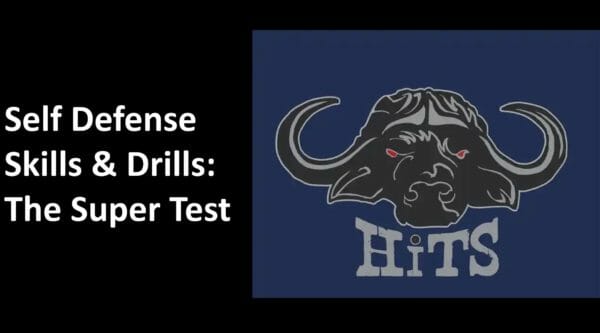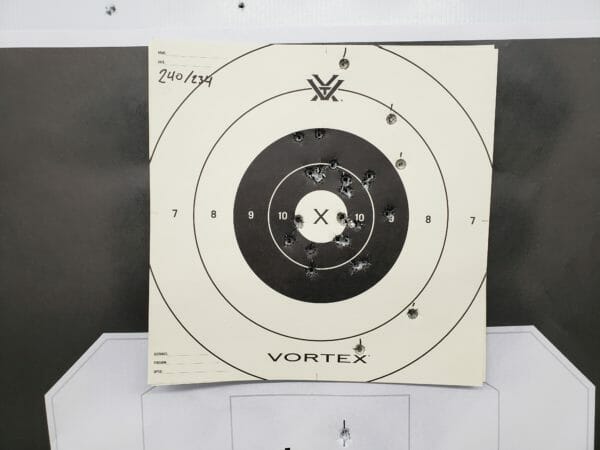
U.S.A. –-(AmmoLand.com)- Often times our drills and courses of fire are focused on a single distance and a single par time. While this can provide us decent training, it requires us to find other methods to broaden our skillset. Luckily, we’re not stuck with single stage drills. The Super Test, as created by Hardwired Tactical provides us a medium round count course of fire that tests a variety of skills, from very short to medium pistol ranges. How exactly does one shoot the Hardwired Tactical Super Test?
Setting Up the Drill
There isn’t much prep work required to shoot the Super Test. You’ll need your pistol, 30 rounds of ammunition, magazines that hold at least 10 rounds, and a shot timer. The drill is fired from low ready, so no holster is required here. The entirety of the Super Test is shot on a B-8 Bullseye or Repair Center, of which you’ll need at least one.
Shooters start with ten rounds in the gun with a loaded chamber. No reloads are performed on the clock, so as long as you have one magazine, you’ll be good. No special provisions are made for optics, different sizes of guns, etc.
Scoring the Super Test
Scoring is very straightforward on the Super Test. Breaking the par time on any string is a failure of the drill. There are no bonuses for faster runs outside of passing the par time. Each scoring ring provides the number of points listed; X and 10 rings give 10 points, 9 ring for 9 points, and so on and so forth. A clean miss subtracts a full ten points. A passing score requires the shooter to make all three par times while also scoring 270 points out of a possible 300.
Firing the Drill
Shooting the Super Test is simple. There are three stages that you’ll fire, each with it’s own par time and distance requirements. Every stage is fired from low ready, no drawing is required. Here are the three stages to the Super Test:
- Stage One: Distance is 15 yards. On the beep, raise your pistol and fire ten rounds into the target, freestyle. Par time is 15 seconds.
- Stage Two: Distance is 10 yards. On the beep, raise your pistol and fire ten rounds into the target, freestyle. Par time is 10 seconds.
- Stage Three: Distance is 5 yards. On the beep, raise your pistol and fire ten rounds into the target, freestyle. Par time is 5 seconds.
Once finished, you’ll count all your points for a cumulative score. Some shooters use the same target for all three stages, but I find that it can become difficult to count up your points. Instead, I prefer to use one target per stage, marking my points and time on each. While this is slower and requires more effort, I think it pays off in the long run.
My Results on the Super Test
The Super Test used to be something I shot fairly regularly back in 2018 and 2019. Over the past few years, it’s fallen out of my standard rotation, but I’ve managed to shoot it a few times in recent memory.
In February of 2021, I headed up to the Vortex Optics facility in Wisconsin for a class with Steve Fisher of Sentinel Concepts. As part of the course, Steve had us shoot a Super Test from the holster, also known as an Advanced Super Test. For this, I used my Glock 34 with an Aimpoint ACRO, shot from AIWB concealment in my KSG Armory Halcyon holster. Despite shooting fairly poorly all weekend, I managed to nab a passing score with a 281 out of a possible 300 points. For Fisher’s class, we only count hits in the black, 9 ring or better. While that isn’t the standard scoring method for a Super Test, higher accuracy standards aren’t a bad thing. Using this non-traditional scoring, I would’ve landed 240 out of 300 possible points.

My Second Chance
The next time I shot the Super Test was on the 25th of November, 2022. This was during regular range time with friends and family at a public range out in the desert. For this run, I used my Glock 19 with a Trijicon SRO mounted on a C&H Precision MOS plate. The ammunition was Blazer Brass 115gr 9mm. For this attempt, I focused on shooting with a flash-sight picture. This sped me up significantly but also cost me some points. Below are my times for each string of fire:
- 15 Yards: 8.66 seconds, 93/100
- 10 Yards: 5.90 seconds, 90/100
- 5 Yards: 3.02 seconds, 99/100
- Total score: 286/300
Overall, I saw a slight improvement in my scores for my most recent run. Interestingly, I nearly made a perfect run at the five-yard stage, which is often considered the more difficult portion of the Super Test. At the ten-yard line, I definitely felt like I was moving a little too quickly, which is reflected in my score, though still a passing run. With no bonus points awarded for shooting faster, I typically recommend maximizing your par times for better accuracy.
Background on the Super Test
Recently I spoke with Darryl Bolke about the origins of the Super Test. As one of the two guys who came up with the drill, he seems to have a pretty good handle on how it came to be. If the name didn’t give it away, the Super Test is an offshoot of The Test, as created by Larry Vickers and modified by Ken Hackathorn.
In short, the Super Test is both a performance evaluation tool, along with an acknowledgment of Ken’s contributions to the shooting world. Testing precision, recoil control, and the balance of speed and accuracy between the three stages, Bolke expects those who pass this drill to have a solid understanding of shooting, along with the ability to teach others.
Final Thoughts on the Super Test
Overall I like the Super Test. Working everything from more precision shots at increased distances to recoil control and nearly contact range. Some of these stages are deceptively simple but often fall off the rails when not applying solid fundamentals. At thirty rounds in total, it allows us to shoot the drill in a single box of ammo while still leaving rounds to work other skills in a short-range trip. Additionally, the lack of a drawstroke helps The Super Test be a possibility for those of us unable to draw from the holster at our local range.
Have you shot the Hardwired Tactical Super Test? If so, let us know your scores in the comments!
About Dan Reedy
Dan is an Air Force veteran, avid shooter, and dog dad. With a passion for teaching, he holds instructor certifications from Rangemaster, Agile Training & Consulting, and the NRA. He has trained with Darryl Bolke, Mike Pannone, Craig Douglas, among several other instructors, amassing over 400 hours of professional instruction thus far. In his spare time you’ll find him teaching handgun, shotgun, and less lethal classes.
Dan’s work has been published by Primer Peak, and The Kommando Blog, and he has been featured as a guest on Primary & Secondary.


I regularly do civilian self-defense training and I discourage students from raising their firearm to a target and emptying their magazine. I promote ‘shoot and assess’ which means you move on (multiple targets) or stop (single target) with a good hit, shoot again if not a good hit. No more than 3 rounds before you take a breath and start over.
These drills can be fun and competitive, but if you train to empty your mag, that’s what you will do under stress. Similar drill with 1-3 rounds per par time and I’m in.
10 rds in 5 seconds into a single target? I think 3 rds each into 3 separate targets are far more appropriate for a defensive strategy and far more realistic. Far too many rounds if a Democrat was the DA and wanted to prosecute. Too many defensive shoots end with only 1 rd being fired as that is muscle training on the range. Also from 5 yds do instinct shooting and not use your sights. I went through some excellent training classes on shooting that style and it can be learned. I will have 3 shots off, accurately, before you… Read more »
Range shooting is traditionally done at distance. But almost all defensive action occurs close quarter. Like inside a car. Or a bathroom or on a staircase. Even when badly wounded or even dying.
Well, I note that Reedy seems to be getting a bit better. He can finally admit to being less than perfect: “At the ten-yard line, I definitely felt like I was moving a little too quickly, which is reflected in my score, though still a passing run.” With that qualifier, but yet still a big step. Perhaps he’s now confronting his mental instability. The required first step towards getting better. Excellent job Mr. Reedy!Congrats! OFC, its also filled with the standard self-gratification (“Interestingly, I nearly made a perfect run”, etc.), but that’s to be expected. Problems this deep must be… Read more »